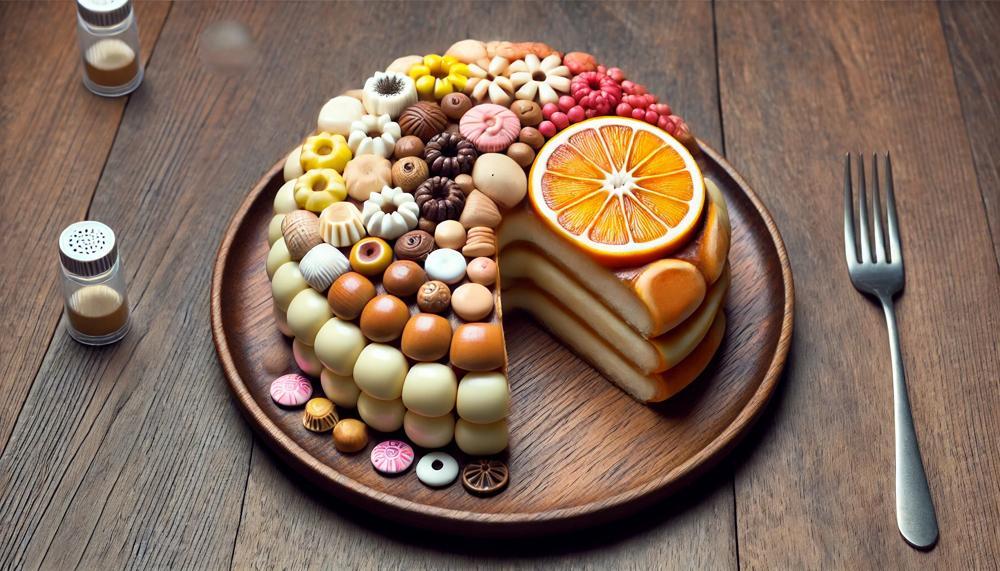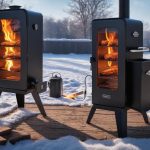Yes, the fat cap should be placed down when smoking meat. This positioning helps to protect the meat from the direct heat, preventing it from drying out and ensuring even cooking.
Placing the fat cap up, a common practice among many, can lead to the fat not fully rendering, which can create an unappealing texture and prevent the seasoning on the meat’s surface from forming a good crust.
So, why is this important for your smoking endeavors? Here’s the lowdown:
- Direct Heat Protection: Placing the fat cap down shields the meat from direct heat, helping to maintain moisture and avoid charring.
- Better Smoke Penetration: Fat cap down allows for better smoke penetration into the meat, enhancing the flavor profile.
- Crust Formation: Positioning the fat cap down encourages the formation of a delicious, smoky crust on the meat, making for a tastier bite.
- Enhanced Flavor: By preventing the fat from pooling on the meat, this method ensures the fat renders properly, contributing to a richer, more robust flavor.
Experiment with your smoker and find the best setup for your taste, but starting with the fat cap down is a tried and tested way to elevate your smoking game. Dive into this flavorful debate and discover the technique that brings out the best in your barbecue.
Contents
- 1 Do We Smoke A Brisket Fat Side Up Or Down?
- 2 What is The Brisket Fat Cap?
- 3 Why Should You Smoke A Brisket Fat Side Down
- 4 What Will Happen If We Smoke A Brisket With The Fat Side Up?
- 5 What Happens To Fat During The Cooking Process?
- 6 What Is The Best Temperature To Smoke A Brisket?
- 7 How Long Do We Smoke A Brisket?
- 8 What Is The Desired Internal Meat Temperature For A Smoke Brisket?
- 9 Want to Go From Amateur to Pitmaster?
- 10 Conclusion
Do We Smoke A Brisket Fat Side Up Or Down?
Here’s a detailed look at the pros and cons of each method to help you decide:
| Method | Pros | Cons |
| Fat Side Up |
|
|
| Fat Side Down |
|
|
Additional Considerations:
- Type of Smoker: For offset smokers, where heat comes from one side, fat side down can protect the meat from direct heat. For smokers with a water pan or indirect heat, this factor might be less critical.
- Personal Preference: Many pitmasters have their preferences. Experiment with both methods to see which you prefer.
- Trimming Fat: Another option is trimming the fat off entirely, although this can impact the brisket’s flavor and juiciness.
In essence, whether to smoke a brisket fat side up or down boils down to your personal preference and the type of smoker you use. Experimenting with both methods will help you find what works best for your setup.
What is The Brisket Fat Cap?
The fat cap on a brisket serves multiple purposes during the smoking process, significantly impacting the texture and flavour of the meat.
The purpose of the fat cap on a brisket:
- Moisture Retention: The fat cap helps keep the brisket moist by rendering during the smoking process. This slow melting of fat bastes the meat, preventing it from drying out over long cooking periods.
- Protection: It acts as a barrier between the heat source and the meat, reducing the risk of the brisket drying out or burning, especially when placed fat side down.
- Flavour Enhancement: As the fat renders, it infuses the meat with rich, smoky flavours, enhancing the overall taste profile of the brisket.

How the fat cap affects the smoking process:
| Aspect | Effect | Details |
| Rendering | Moisture | As the fat melts, it bastes the meat, maintaining its juiciness. |
| Heat Protection | Insulation | Fat cap can protect the brisket from direct heat, preventing it from drying out. |
| Orientation | Airflow | Placing the fat cap towards the heat source maximizes airflow and aids in even cooking. |
| Trimming | Render Efficiency | Trimming the fat cap to 1/4 to 1/2 inch thick allows for optimal fat rendering without excessive grease. |
For those interested in mastering brisket smoking, understanding the role of the fat cap is essential. Whether you choose to place the fat side up or down depends on your smoker and personal preference. Experimenting with different orientations and trimming techniques can help you achieve the perfect balance of moisture, flavour, and texture.
Why Should You Smoke A Brisket Fat Side Down
Smoking a brisket with the fat side down offers several key benefits that can enhance your barbecue experience. Here’s a detailed look at why this method is preferred:
| Benefit | Explanation |
| Moisture Retention | The fat cap keeps the meat moist by rendering and basting the brisket. |
| Heat Protection | The fat layer shields the meat from direct heat, preventing overcooking. |
| Better Bark Formation | Direct exposure of the meat side to heat enhances bark texture and flavour. |
| Grease Control | Melted fat drips away, reducing greasiness in the final product. |
| Even Cooking | Rendered fat evenly distributes heat, promoting consistent cooking. |
| Reduced Cooking Time | Fat acts as a heat conductor, potentially reducing overall cooking time. |
By smoking your brisket with the fat side down, you ensure a more flavourful, tender, and evenly cooked piece of meat, enhancing your overall BBQ experience.
What Will Happen If We Smoke A Brisket With The Fat Side Up?
The short answer is, smoking a brisket with the fat side up helps keep the meat moist by allowing the melting fat to baste the meat, while smoking with the fat side down protects the meat from direct heat and helps develop a crispier bark.
| Fat Side Up | Fat Side Down |
|
|
What Happens To Fat During The Cooking Process?
When smoking meat, the placement of the fat cap significantly impacts the cooking process and the final outcome. Here’s how:
Fat Cap Placement: Fat-Side-Down
- Heat Protection:
- Placing the brisket fat-side-down acts as a barrier between the meat and the heat source. This helps prevent over-exposure to heat, which can dry out the meat.
- Creates a crispier bark on the meat side, adding to the texture and flavour.
- Bark Formation:
- The meat side, being more exposed, develops a harder, more desirable bark. This is preferred by those who enjoy a crunchy exterior on their smoked brisket.
- Moisture Retention:
- The fat cap shields the meat from direct heat, which helps in retaining moisture, ensuring a juicier end product.
Fat Cap Placement: Fat-Side-Up
- Self-Basting:
- When the fat cap is on top, it melts during cooking and drips down over the meat, basting it. This can keep the meat moist and enhance its flavor.
- Flavor Infusion:
- The melting fat can carry seasonings deeper into the meat, improving overall taste. However, this can sometimes wash off the seasoning applied to the meat surface.
- Texture and Moisture:
- Although it can add moisture, fat-side-up placement does not protect the meat from direct heat, potentially resulting in a softer bark and a different texture.
Considerations Based on Smoker Type
- Offset Smokers: Typically benefit from fat-side-down to shield the meat from the direct heat source.
- Electric Smokers: Use indirect heat, making the fat cap placement less critical. However, personal preference for bark and moisture can guide the decision.
What Is The Best Temperature To Smoke A Brisket?
The best temperature to smoke a brisket is 225°F (107°C). This temperature ensures that the brisket cooks slowly, allowing the connective tissues to break down and the meat to become tender and flavorful. Smoking at this temperature also helps to maintain a consistent heat that avoids drying out the brisket.
For a truly mouth-watering, Texas-style brisket, keeping your smoker at 225°F (107°C) will yield the best results. At this temperature, the brisket absorbs the smoky flavor while cooking evenly, resulting in a succulent and juicy final product.
Smoking Temperature Guidelines
| Temperature (°F) | Temperature (°C) | Effect on Brisket |
| 200-225 | 93-107 | Slow and steady cook, tender meat with good smoke absorption |
| 225 | 107 | Ideal for Texas-style brisket, optimal balance of tenderness and flavor |
| 250-275 | 121-135 | Faster cook, risk of drying out, still flavorful |
Additional Tips
- Use a Water Pan: This helps maintain humidity inside the smoker, keeping the brisket moist.
- Monitor Internal Temperature: Aim for an internal temperature of 195-205°F (90-96°C) for doneness. Use a meat thermometer for accuracy.
- Rest the Brisket: After smoking, wrap the brisket in foil and let it rest for at least 1 hour to allow the juices to redistribute.
How Long Do We Smoke A Brisket?
Smoking a brisket is a culinary journey requiring patience and precision. The recommended smoking time for a 12-13 pound brisket is approximately 8 hours at 250°F (121°C). This duration is critical to achieve a perfect balance of tenderness, flavour, and moisture.
| Weight of Brisket | Temperature | Smoking Time |
| 12-13 pounds | 250°F (121°C) | 8 hours |
| Smaller cuts | 250°F (121°C) | Varies (shorter time) |
| Whole brisket | 250°F (121°C) | 8-10 hours (including prep and rest) |
Importance of Smoking Time
- Tenderness: The extended smoking time allows the connective tissues in the brisket to break down, resulting in a tender bite. The collagen transforms into gelatin, creating a succulent texture.
- Flavor Development: Slow smoking infuses the brisket with rich, smoky flavours. The Maillard reaction, which occurs during this time, enhances the meat’s savoury notes.
- Moisture Retention: Wrapping the brisket in butcher paper or foil halfway through smoking helps retain moisture, preventing the meat from drying out.
- Resting Period: After smoking, resting the brisket for at least an hour is crucial. This step allows the juices to redistribute, ensuring every bite is juicy and flavourful.
What Is The Desired Internal Meat Temperature For A Smoke Brisket?
The ideal internal temperature to achieve a perfectly smoked brisket is between 190°F and 203°F, with 195°F being the “sweet spot.” To ensure your brisket reaches this ideal temperature, follow these steps:
- Use a Reliable Meat Thermometer: Invest in a high-quality meat thermometer to accurately monitor the internal temperature.
- Probe the Thickest Part: Insert the thermometer into the thickest part of the brisket, avoiding bones, and aim towards the center for an accurate reading.
- Check Multiple Spots: Test the temperature in various areas to account for any inconsistencies and ensure even cooking.
- Monitor the “Stall” Phase: Be patient during the stall phase, where the temperature plateaus. It will eventually rise again.
- Observe Visual and Textural Cues: Alongside temperature, check for a crispy exterior and a tender interior to gauge doneness.
Here’s a quick reference table to help you:
| Temperature Range | Description | Tips |
| 190°F – 203°F | Ideal internal temperature for a perfectly smoked brisket. | Aim for 195°F as the optimal target. |
| Below 190°F | Connective tissues haven’t fully broken down, resulting in tough meat. | Continue cooking to reach at least 195°F. |
| Above 203°F | Risk of drying out the brisket, leading to an unpleasant texture. | Avoid exceeding 210°F to maintain juiciness. |
Want to Go From Amateur to Pitmaster?
The difference between an amateur and a pitmaster in smoking meat is profound, touching on technique, equipment, and experience.
| Aspect | Amateur | Pitmaster |
| Equipment | Amateurs often use pellet smokers for convenience and ease of use. | Pitmasters favour offset smokers for their ability to control fire, wood, and airflow, which significantly influences the meat’s flavour and texture. |
| Fire Management | Relies on automatic settings and less hands-on control. | Skilled in managing fire manually, understanding the nuances of different wood types, and adjusting airflow to maintain consistent temperatures. |
| Technique | Follows basic recipes and general guidelines without deep understanding. | Utilizes advanced techniques, such as the “Texas crutch,” and can judge doneness by sight, touch, and smell. |
| Experience | Limited experience with a focus on simple, straightforward smokes. | Years of practice and often competitive experience, understanding the intricacies of different meats and cuts. |
| Result | Produces decent, enjoyable smoked meat but may lack depth in flavour and consistency. | Creates exceptional, competition-worthy smoked meat with a profound depth of flavour, perfect bark, and tender texture. |
Conclusion
Smoking meat is an art, and the debate over whether the fat cap should be up or down is a key part of that discussion. The fat cap, a layer of fat on the meat, plays a crucial role in the smoking process. For optimal results, placing the fat cap down is generally the preferred method. Here’s why:
- Direct Heat Protection: Positioning the fat cap down shields the meat from direct heat, helping to maintain moisture and prevent drying out. This protection is especially beneficial in smokers where the heat source comes from below.
- Better Smoke Penetration: With the fat cap down, the smoke can penetrate the meat more effectively, enhancing the flavor profile. This setup also aids in the development of a rich, smoky crust, or bark, which is a sought-after feature in smoked meats.
- Flavor Enhancement: By ensuring the fat renders properly and drips away, the meat avoids a greasy texture and instead benefits from a richer, more robust flavor. This method also prevents the pooling of fat on the meat’s surface, allowing the seasoning to form a good crust.
- Even Cooking: The rendered fat helps distribute heat more evenly across the meat, promoting consistent cooking and avoiding hot spots. This ensures the entire cut is cooked to perfection, resulting in a tender, flavorful dish.
So, while some pitmasters may prefer the fat cap up for natural basting, the benefits of placing it down are clear. It protects the meat, enhances smoke penetration, promotes crust formation, and ensures even cooking.






